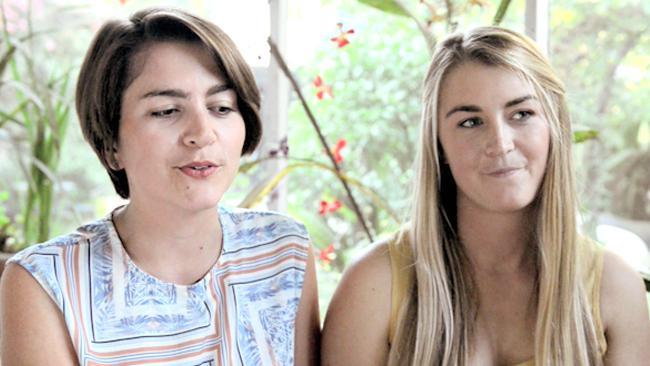Fred Hollows’ twin daughters witness his life’s mission in Nepal
ON a visit to Nepal, Fred Hollows’ twin daughters rediscover his life’s mission – and his stubborn, big-hearted character.

THE cremation has gone terribly wrong. A foot, grotesquely swollen by the flames, is sticking out from the funeral pyre on the banks of the holy Bagmati River in Kathmandu, Nepal’s capital.
A man in rags is desperately trying to push the errant appendage back into the fire with a stick amid wails from horrified relatives. The smoke and ash from the burning corpse wafts over Ruth and Rosa Hollows, who try not to look as they walk past, but it’s too late. Rosa looks like she wants to retch. Ruth’s face has gone blank.
“Wow, that is pretty bad,” Ruth splutters. “Yeah it’s pretty confronting,” replies Rosa. “You OK?” Ruth asks her twin sister. “Yes,” says Rosa unconvincingly. The daughters of celebrated eye surgeon Fred Hollows have come to this river to see the place where corneas are cut out of corpses minutes before they are cremated and then rushed to the nearby eye hospital to be inserted into the blind, restoring their sight.
It’s a gruesome harvest, but one which changes lives. Ruth takes a deep breath and regains her composure. “It’s all part of it,” she says with a quiet determination as she walks away from the six funeral pyres that are ablaze in a single file along the riverbank. “It’s a part of connecting it to Dad.”
Connecting it to Dad has been a lifelong challenge for the Hollows twins, the youngest of the five children of Fred and Gabi Hollows. They were conceived on Anzac Day 1989, when Hollows already knew he was dying from the cancer that had been diagnosed three months earlier. Hollows described their conception as a “strange twist of fate” and wrote the following year: “Ruth and Rosa may not remember me but then again they just might. Gabi has a theory that I am stubborn enough to stick around long enough to make sure they do.” The twins were just shy of their third birthday when Hollows died on February 10, 1993, aged 63.
At his state funeral in Sydney they were the toddlers from hell, with Rosa repeatedly making the windows go up and down in the government limousine on the way there, while Ruth chewed on a clump of Blu Tack only to drop it inside St Mary’s Cathedral and cause a scene as she ran crying back down the aisle to retrieve it. They were oblivious to the presence of 3000 people, including three prime ministers, surgeons, philanthropists, poets and powerbrokers, who had come to pay homage to a man whose stubborn determination for his cause had restored sight to countless people around the world.
Alone among the Hollows children, Ruth and Rosa have had to contend with the fact that much of Australia remembers their father better than they do. For them, he will always come to life only through old photos and TV clips rather than in their heads. “I have tried so hard but I don’t remember him,” says Rosa. Adds Ruth: “Sometimes I think I have a memory of his voice, but I don’t know if it is so much my memories or because I have heard his voice a lot on recordings and footage of him in interviews. So sometimes I think I can almost say it is mine, but I can’t be sure. I like to think of it as a collective memory: it’s not just informed by my memory, because we don’t have a strong memory of Dad, but everybody is contributing to it.”
While they are clearly in awe of what their father achieved, it’s hard to properly grieve the loss of a man they can’t remember, except to wonder what might have been. These days they refer to their father as “Fred” more than “Dad”. While they grew up without their father, the twins have not been without a father-figure because they are close to their stepfather John, who married Gabi in 1996 and who has raised the girls as his own since they were six. “Our stepfather came along and he has been as big a part of our life as our father; for me, we grew up with two parents like anyone does,” says Rosa.
The twins have also grown up with their Dad’s philanthropic giant, The Fred Hollows Foundation. At school they had to endure with a mixture of pride and embarrassment class projects on Hollows and his work. From a young age at the dinner table they knew their cataracts from their corneas and heard tales of the fabled intraocular lens factory in Nepal which promised to deliver their Dad’s dream of an affordable cure to the scourge of cataract blindness in the developing world.
Now Ruth and Rosa, 24, are moving to reclaim some of Fred Hollows for themselves by walking in his footsteps in Nepal, the country that spearheaded his global quest to cure blindness; to see what their father helped to create but never lived to see. Hollows brought them here in 1992, a year before he died, but they were too young to remember.
“I really wanted to come here with Rosa,” says Ruth at she sits with her sister at a house overlooking the Kathmandu Valley. “We are the youngest and while we don’t do everything together I really like to do the big things, the important things together so we can share it and talk about it.”
It’s a pilgrimage they’ve taken without knowing how it might affect them.
I meet Ruth and Rosa in Kathmandu’s medieval Durbar Square, on the eve of their week-long journey. It is clear they are not only twins but best friends. They finish each other’s sentences, talk over each other in their haste to tell stories, and possess a sister’s ability to communicate without words. They shared the same room until they were 22 and still do when travelling together. “We shared a womb, we can share a room,” they like to say.
Yet they are surprisingly different. Ruth is a brown-eyed brunette while Rosa is a blue-eyed blonde. Ruth is natural talker, like her mother, and is comfortable in the spotlight. She has a bachelor’s degree in theatre and development studies and wants to become a project manager for an NGO, a path that seems likely to lead back to the Hollows Foundation.
Rosa is more headstrong, like her father, and less tolerant of the media attention her family lineage brings. Hollows called Ruth “Seek” and Rosa “Destroy”. A keen snowboarder and ski instructor, Rosa has already forged a road less travelled, becoming a qualified carpenter on the 21st anniversary of her father’s death in February this year. She is a chip off the old block: carpentry was Hollows’ passionate hobby. Sawdust from his workshop was placed in his coffin along with whisky and a pipe before he was buried, according to his wishes, in the red dirt of the NSW town of Bourke.
In April, when Rosa’s boyfriend dropped down on one knee on a ski run in Utah and asked her to marry him, she said yes. “She knows what she wants, she is always determined, really strong-willed but also very fun, she loves an adventure,” says Ruth. “Sometimes I hold back a bit but she is brave in a lot of aspects of her life.”
“They are both very different even if they often echo each other,” says Gabi, as she holds up a picture of the twins during a Skype interview from her sprawling sandstone mansion in Sydney’s Randwick. “But they’ve got a bit of everything in them and a bit of everybody in them.
“I wish I was with you,” she tells her daughters. “It’s a dream that has come true, and for every person who we touch, it is so important and so exciting.”
Both girls are compassionate, bright and worldly for their years, which Gabi puts down to them being brought up in a house where so many talented, high-profile people have passed through either as family friends or supporters of the foundation. “The kids have had such incredible exposure to so many amazing people all their life and I think this has literally opened their eyes wide [to the world],” Gabi says.
Both before and after Hollows died Farnham House was open to friends, some of whom would move in for months or even years. “Growing up we would always have to set a spot at the dinner table each night for a ‘mystery guest’, even if we didn’t know anyone was coming over, because we knew that someone probably would,” recalls Ruth.
Their other siblings from Fred and Gabi’s marriage, Emma, 39, an environmental scientist, Cam, 33, a doctor, and Anna-Louise, 26, a nurse (Fred also had two children from his first marriage, Tanya and Ben) have all observed Hollows Foundation work overseas. Rosa has been to Vietnam to watch eye surgery but neither of the twins has witnessed the miraculous moment when eye patches are taken off patients and they can see again.
We take a taxi through the early morning chaos of Kathmandu, dodging cows and rogue trucks, heading towards the eye hospital now known as the Tilganga Institute of Ophthalmology, which houses Hollow’s singular dream: the lens factory he conceived of but never saw.
When Fred died in 1993 he had set in motion an idea which has since revolutionised eye surgery in the developing world, restoring sight to more than a million men, women and children across Africa and Asia. It harks back to a visit Hollows made to Nepal in 1985 to assess the blindness prevention program in a country where 70 per cent of blindness was caused by cataracts, a clouding of the eyes often caused by age but also by exposure to sun, diabetes and other health conditions. Cataracts could be cured by surgery in the West but the operation was unaffordable to many patients in developing countries because of the cost of intraocular lenses, which are inserted into the eye to restore sight after the cataracts are removed.
While in Nepal, Hollows met Sanduk Ruit, a young ophthalmologist who was to become his best friend and willing partner in what would be a remarkable dual assault on the accepted medical opinion at that time about preventable blindness. Hollows was intrigued by Ruit’s unusually nimble surgical skills and by his willingness to test boundaries. In 1988 he invited Ruit to Sydney, where he worked at the Prince of Wales Hospital and lived with the family at Farnham House for 14 months.
Ruit and his new wife Nanda immersed themselves in the boisterous Hollows household and it was there that Hollows conceived the radical idea of making intraocular lenses in Nepal at a fraction of the cost of those produced in the West. Amazing as it now seems, this cheap-lens concept was ridiculed at the time by the medical establishment, which said it could not be done both cheaply and safely.
“One of the things I really liked about [Fred] was that he wasn’t really scared of anybody,” Ruit tells me. “One of the best things we tried to share over long hours over whisky was that the world has tremendous inequity and we wished we could at least bring equity in eye health care.”
The Fred Hollows Intraocular Lens Laboratory opened in 1994 and it now pumps out 400,000 lenses a year for $US5 each, compared with $100 in the west. They are exported to 70 countries across Africa and Asia. The foundation has another lens factory in Eritrea and together these factories have now produced about five million cheap lenses.
For Ruth and Rosa, visiting the lens laboratory and the Tilganga hospital is a homecoming of sorts, a confirmation of the family dream that hung over the dinner tables of their youth. “Just seeing that building we’ve been talking about for such a long time, and which has been such a part of our lives, will be cool,” says Ruth as she walks past the Bagmati River towards the hospital for the first time.
But the moment she walks down the alley leading to the hospital and spots the Tilganga Institute of Ophthalmology sign, she loses her cool. Her face breaks into a grin that seems to swallow her entire face. She is still grinning as they walk into the hospital, where hundreds of Nepalese are waiting for treatment. In one room they bump into the CEO of the institute, Dr Reeta Gurung, who was once one of those mystery guests at Farnham House. Gurung squeals with delight and grabs them both in a bear hug as if they were her own daughters.
Eventually the girls make their way to the ground-floor lens factory where a large portrait of Fred is painted on the wall near the entrance. Ruth reaches out to touch it as she walks in. They are guided through the laboratory and shown how the lenses are made. As they leave, Rosa writes in the visitors’ book: “Like my father said, ‘You need your tools of your trade to get the job done’ and this is a fine example of that – Rosa Hollows.”
Ruth and Rosa have not come to Nepal just to see the hospital. They want to experience for themselves what their father’s work means to the people he most wanted to help: the poor farmers for whom blindness can be akin to a death sentence. Cataract sufferers in rural and remote regions of the country are often unable to travel to Kathmandu for treatment. So the 59-year-old Ruit regularly travels to them, often driving or walking for a day or more to conduct eye clinics.
Hollows once said that if he had done nothing in life but encourage Ruit, he would die happy. This week, Ruit’s mobile clinic is being set up at one of the most revered Buddhist sites in Nepal, Pullahari Monastery. Perched on a hill on the outskirts of the Kathmandu Valley, with prayer flags fluttering from the surrounding trees and pagodas, the monastery is home to around 200 monks, many of them young boys.
When we arrive, after a bumpy ascent in a battered bus carrying doctors from Thailand, Indonesia and Burma, teams of monks are carrying tables, chairs and other equipment to set up the clinic, which includes a makeshift operating theatre on the top floor of the monastery.
Rosa the carpenter mucks in immediately, putting together the benches for the operating theatre ahead of the first of the 250 patients who arrive by bus later that afternoon. All of the patients suffer some form of blindness in one or both eyes; most have been led or carried by relatives for many hours from their villages to the place where the buses picked them up. They are from some of the poorest and most remote regions of Nepal and many arrive barefoot, wearing little more than rags.
The patients are guided into the building where young monks sit in front of eye charts, pointing at letters with a stick to test the extent of their blindness. Among the many dozens of patients waiting for an eye test, two stand out because of their completely blank expressions. Lapka Tamang, 82, and Mansang Tamang, 65, are not related but have come to the clinic in the hope that Ruit can change their lives. Lapka, who arrived barefoot, has been blind in both eyes for more than a year. He can’t go to the toilet by himself or look after himself in any way. His children, who have to work the fields, leave him alone all day inside his tiny house or outside on a chair if it is sunny. He wants to get his sight back so he can stop being a burden to his family and so he can see his youngest grandson, who is now 10 years old.
Next to him sits Mansang, who’s also been blind in both eyes for more than a year. Her husband must do everything from working their farm to cooking their meals and housework while Mansang is left alone and helpless on the bed all day.
On this afternoon, Ruth and Rosa are preparing the patients for the next day’s surgery, helping to test their eyes, filling out paperwork, talking with them, holding their hands. As night falls, more patients are coming in and the energy levels of the monks and helpers begin to flag. Afterwards, Rosa says: “When we were helping see all the patients through it was getting late and there were still 30 people who had to get their eyes inspected. You could see everyone slowing up a bit, and I thought if Dad was here he’d be saying, ‘Quit standing around and get it f..king done’. So I thought, ‘Well, suck it up Rosa and just get it done’.”
The next day, the man described by Gabi Hollows as the “living god of ophthalmology” arrives at the monastery. Ruit heaves his large frame from the car and a huge smile spreads across his round face as he embraces Ruth and Rosa. “So glad to see you,” he says.
An hour later, Ruit is in the operating theatre with the first of the 52 patients he will see today. The surgeon has so far restored the sight of more than 120,000 people, larger than an AFL grand final crowd, using his own technique in which he slices out the cataract and then places one of the $5 lenses, which he calls “Freds”, into the eye. Ruit’s technique requires no stitches, saving time and cost and reducing complications. Each operation takes less than 10 minutes and is so efficient that two patients at a time are laid out head to head so he can move from one to the other without a break.
As Ruit is operating, barefoot and with his favourite Nepalese love songs playing in the background, Ruth and Rosa walk in. Seeing their father’s best friend doing what they have always heard about seems to turn these young women into little girls again. They smile nervously and politely answer his questions as one might respectfully answer a grandfather. It’s clear they are in awe of him.
“It’s like making sense of a story you’ve heard your whole life,” says Ruth as she watches Ruit. As the surgeon slices out another cataract, Rosa tells him she is a carpenter. “Ah, interesting,” replies Ruit, his eyes never moving from his microscope. “Carpentry was Fred’s expression of frustration. Whenever he got frustrated he would disappear into his shed.”
When Rosa tells him she is going to be married, he nods approvingly and asks about Ruth, who declares she is single and “the spinster of the family”. He asks the girls how Gabi is and then, as he inserts another lens into the eye of a 60-year-old woman, he adds: “I think Fred could have married only Gabi. Only she could have stood him because he was so difficult. My hat goes off to Gabi.”
Later, as I chat with Ruit during a break in surgery, he tells me what it means to have Ruth and Rosa visit Nepal. “My first memory of Ruth and Rosa is outside Farnham House. There was a mango tree and there was a little treehouse up there and I remember Fred holding each of them in his two hands and putting them in the treehouse.
“For us, the children are really our children. So it is a huge impact for us to see them come back here… I don’t think we could have done all this without Fred.”
Since Fred’s death Gabi has dedicated her life to the Hollows Foundation and has transformed it into one of Australia’s most popular and best-known charities; the foundation says its public donations have grown from $7.2 million in 2003 to $42.5 million in 2013, while government grants have risen in that same period from $1.9 million to $10.5 million.
Despite this, Ruth and Rosa – who have both embarked on 50km and 100km walks to raise funds for the foundation – say they have not been raised with the expectation that they will eventually work full-time for the cause, although neither rules it out. Says Ruth: “I don’t feel pressure, but when mum was given an Order of Australia last year – so now we have parents with an AC and an OC – it’s like, ‘Well, OK, now do people expect us to also do great things? And what if I [can’t do] great things?’ That pressure has never been put on us, thankfully. It has never been said that you have to do great things but you find yourself wanting to contribute to something that has meaning.”
The next morning, Ruth and Rosa have been given the honour of taking the patches off the eyes of the first 100 patients Ruit and the other doctors operated on the previous day. The patients are led in single file to a beautiful courtyard behind the temple, a place deliberately chosen so that their first vision would be of trees, flowers and the Kathmandu Valley below.
They sit down on steps overlooking the courtyard as Ruth and Rosa each take off their first eye patch. What happens next is beautiful to behold. Some of the patients break into huge smiles, others laugh, some stare blankly in disbelief at their sudden cure, while others place their hands together in prayer to give thanks.
With each patch they remove, the smiles on the faces of Ruth and Rosa grow larger. The 82-year-old Lapka Tamang, who has regained sight in both eyes, keeps staring at the blue sky in amazement and says he will walk proudly back to his village with a bag of sweets for his young grandson, who he will see for the first time in more than a year. Mansang Tamang, the 65-year-old woman who was also blind in both eyes, can’t stop laughing and keeps glancing around as if to catch up on her years in the dark. When Rosa takes the patch off an 80-year-old, toothless Kumari Gurung, the old lady grabs Rosa’s face in her hands, says “Thank you, thank you,” and then stands up and dances a jig. Rosa is speechless.
Ruth reaches the end of the line and stands before a Hindu lady in a glorious red sari. At 62, Michri Thapa’s life has been cursed by bad luck, losing three of her five children to illness. Blind in one eye, she has also been looking after her elderly and infirm husband.
Ruth takes her patch off and Michri glows as she sees the young Australian with her once blind eye. She stands, puts out her hands and gives thanks to Ruth, blessing her and praying she will have a good and prosperous life. Ruth, who has struggled to keep her composure, finally buckles. Tears well in her eyes. Fred Hollows’ youngest daughters have finally witnessed their father’s dream and, in this perfect moment, it is as if they have come home.
Cameron Stewart visited Nepal with the Fred Hollows Foundation: www.hollows.org.au



